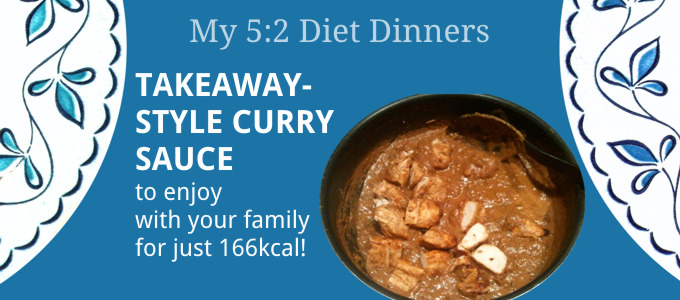The husband of a friend of mine is a chef at an Indian restaurant and some years ago we did a recipe exchange – I showed him how to make my awesome chocolate fudge cake so he could serve it for dessert in the restaurant and he taught me how to make my favourite dish from his menu.
Using the basis of his recipe it’s possible to make all sorts of tasty restaurant style curries, although you may need to buy in some store cupboard ingredients to start off, these will last you for many a delicious curry! This is one I make for feed days and after adding up the calories I realised it could also be a Fast Day dinner! The whole family will love this one and the recipe serves 4 people. The below mild to medium curry recipe is a favourite among us and our friends and has been given the name Murgh Moog, murgh being ‘chicken’ (we usually serve this with chicken) and Moog being me 🙂
The recipe involves preparing two bases for the curry and then the cooking stage.
Ingredients for Onion Gravy Base
- 250g white onions (100kcal)
- Water
- Good pinch of salt
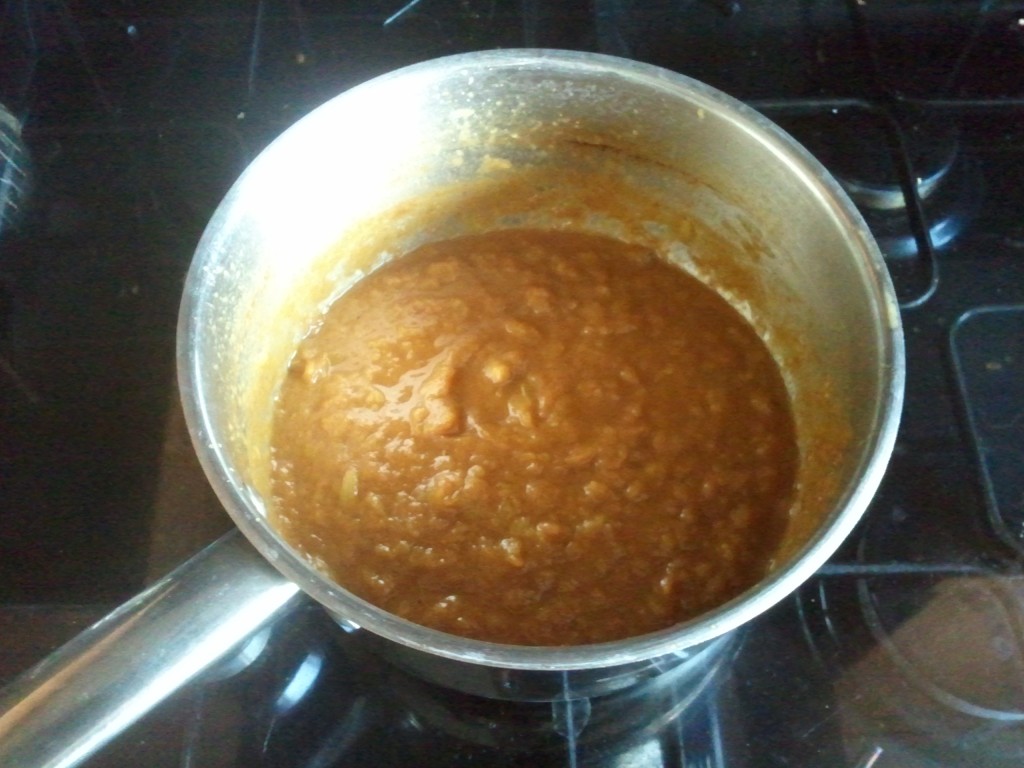
Method for Onion Gravy Base
- You’ll probably want to prep this ahead of time as it takes a while – but is well worth it!
- Roughly chop the onions (I tend to chop them in half, then each half into quarters) and put them in a saucepan.
- Cover the onions with boiling water and add the good pinch of salt.
- Optional: If having this on a non fast day, or if you’ve got enough calories to spare, you might like to add a little splash of oil to this mixture or a teaspoon of curry powder. It’s not essential though and the recipe works well without.
- Put a lid on the pan and heat gently for around 30-45 minutes until the onions are well softened and there’s not lots of water left (remember to check on them regularly, you don’t want them to dry out).
- Remove the mix from the heat, remove the lid & allow to cool.
- When the mixture is cool, use a blender to blitz the mix to a fairly thick, oniony mush.
Ingredients for Curry Sauce Base
- 200g naturual yogurt* (140kcal)
- 1tbsp mint sauce (13kcal) – yes, I do mean like the jars of mint sauce you use with a lamb roast!
- 1tbsp (35g) tandoori paste (32kcal)
- 1tbsp (35g) tikka paste (42kcal)
- Half tbsp kashmiri masala paste (42kcal)
- 15g garlic (22kcal)
- 15g ginger root (12kcal)
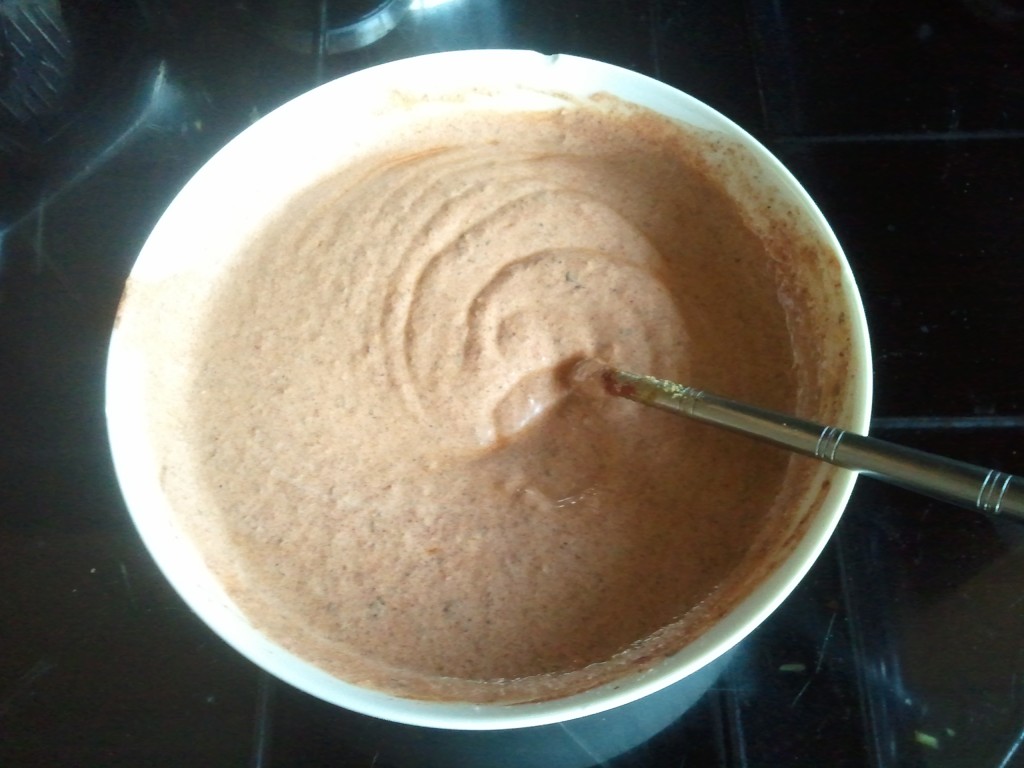
Method for Curry Sauce Base
- Measure the natural yogurt into a bowl and add the various sauces and pastes, stirring well.
- In a pestle & mortar, grind the garlic and ginger into a paste.
- If you do not have fresh garlic and/or ginger you can substitute with a couple of teaspoons granules/powdered forms of each instead.
- Mix around two thirds of the garlic & ginger paste into the yogurt spice base.
- Leave this mix to stand a little while as the flavours will start to infuse in the yogurt.
*I always recommend using full fat yogurt as the fat is what helps bring out the curry flavour. If you prefer to use low fat please make sure it’s not one with added sugar and other nasties. There are low fat yogurts out there with no additives which are much better for you! A greek yogurt may give you a thicker creamier curry whereas a tangy natural yogurt will give an added zing to the flavour. Experiment and see what you like best!
Right, now your onion gravy is prepared, your curry sauce base has stood for a little while and now you’re ready to start cooking!
Ingredients for Curry Cooking Stage
- 50g white onions (20kcal)
- 1tbsp oil (120kcal)
- 1tbsp ground mixed spice
- 1tbsp granulated sugar (45kcal)
- Tin of chopped tomatoes (77kcal)
- Fenugreek leaves Chopped coriander [cilantro] – leaves & stalks
Method for Curry Cooking Stage
Chop the onion to whatever size/shape you prefer the pieces to be in your curry. I like mine quite chunky!
- Heat the oil in a frying pan and add the onion and ground mixed spice, stirring well.
- Next add the tin of chopped tomatoes and continue to fry this as it absorbs the spices.
- Add the remaining garlic/ginger mix you prepared when making the curry sauce base.
- Add the onion gravy base and stir well. Add the curry sauce base and stir well.
- Add the sugar and fenugreek leaves and stir well.
- Continue to cook the sauce gently until it reaches your preferred consistency, adding the chopped coriander right at the end.
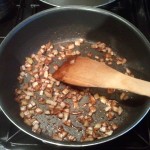
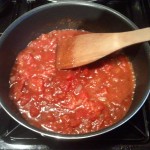
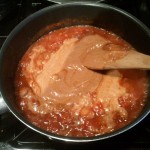
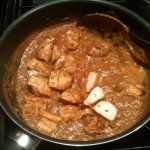
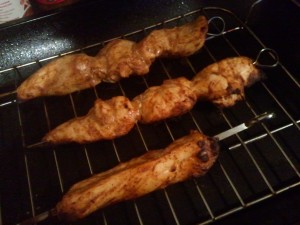
Now you’ll want to add any meat or vegetables you may have prepared to complete the dish. For a fast day I will measure out the portions of sauce first and then add the meat. I normally use chicken, prepared in the oven on skewers, around 100g of chicken (a small breast) per person should be enough. I slice the breast down the middle lengthways, mix all the chunky strips of meat with a little tikka paste or tandoori paste and then put them on skewers in the oven for around 20-25 minutes. You can leave out the paste on a fast day, it’s not essential, although it doesn’t add many calories when spread around all the portions of chicken. On removing the chicken from the skewers I chop each sliver into 3-4 pieces so it looks like the meat from a curry house – it’s got the colouration on the outside, the right shape and even the hole in the middle!
So, we’ve got around 166kcal of sauce with 114kcal of chicken for a total of 280kcal. That leaves you with 220kcal for a side dish – you might want to have some kind of rice (boil with a little turmeric & cinnamon, maybe add some peas!) for that authentic Indian meal, some Indian style cauliflower rice for a low calorie low carb alternative or maybe you just want to mix in lots of tasty veg (spinach is great!) or whip up some simple saag aloo by boiling a calorie counted portion of potatoes in turmeric and gently frying off with some spinach. I’ve got an awesome bombay aloo recipe but it’s not really fast day friendly. I’ll see if I can adapt it one of these days!
Once you’ve got the basics of making a curry in these three stages it’s easy to mix and match your ingredients to make experimental curries – a little more of this, a little less of that, maybe try using a different flavoured oil or putting some chilli powder in with the onion gravy when you cook it. The possibilities are endless and mostly fall within the same sort of calorie range.

